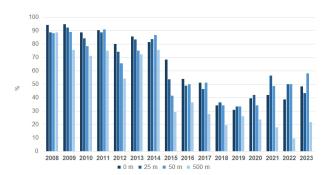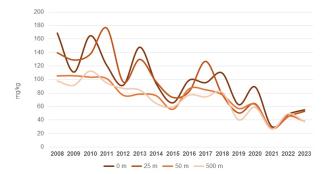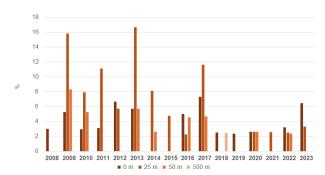Descrizione 1
Stefano Bataloni, Rossella Di Mento, Pasquale Lanera, Giuseppe Trinchera
There are 138 offshore platforms in Italian seas; of these, 42—mainly located in the central and northern Adriatic Sea and dedicated to natural gas extraction—are subject to an environmental monitoring plan. Among the monitored chemical substances are barium and polycyclic aromatic hydrocarbons (PAHs).
Barium is a metal used in the production of drilling fluids and may be present in the produced water periodically discharged into the sea from platforms. PAHs are chemical compounds whose presence in the marine environment is due to both natural factors and anthropogenic activities.
The concentration of barium and total PAHs in sediments surrounding the platforms represents an environmental indicator of the pressure from offshore natural gas field exploitation.
Data available for the period 2008–2023 show a gradual decrease over time in the average concentrations of these contaminants, with the highest values generally found in proximity to the platforms.
Barium concentrations exceeded the baseline reference value in the majority of sediment samples analyzed between 2008 and 2014. However, from 2015 to 2023, the percentage of exceedances fell below 50%.
The percentage of sediment samples with total PAH concentrations above the threshold value—an indicator of probable toxic effects on marine organisms—decreased throughout the period, with the highest levels observed between 2009 and 2017 and around 3–6% from 2018 to 2023. Only in 2018 were PAH concentrations above the toxic threshold found in sediments located 500 meters from a platform.
In Italy, some platforms for offshore hydrocarbon field exploitation are subject to an environmental monitoring plan, generally with annual frequency, aimed at assessing a set of physical and chemical parameters in three environmental matrices: water, sediments, and marine organisms (mussels).
This plan is mandatory to obtain authorization, under Article 104 of Legislative Decree 152/2006, for the discharge into the sea and/or reinjection into deep geological formations of produced water resulting from hydrocarbon extraction activities.
Barium sulfate (barite) is widely used in hydrocarbon extraction activities to increase the density of drilling fluids. These fluids are recovered during the extraction process to prevent their release into the environment; however, barium may still be present in produced water discharged into the sea from platforms and can accumulate near installations (Haanes et al., 2023).
Microparticles of barite, which are poorly soluble, can disperse over long distances before settling on the seabed, where they form complexes with organic matter. In this way, barium becomes non-bioavailable and has low potential toxicity (Neef, 2002; OSPAR Agreement 2014-05).
Nevertheless, knowledge of the distribution of barium levels in marine surface sediments can be used to identify areas affected by discharges from the oil and gas industry.
Marine PAHs derive from both natural phenomena and anthropogenic activities, such as the combustion of organic materials and fossil fuels. Due to their lipophilicity and low solubility in water, PAHs tend to adsorb onto suspended particulate matter and accumulate in marine sediments.
The enrichment of sediments near offshore platforms is only minimally attributable to produced water discharges, since PAH content in treated produced water is generally very low. Rather, enrichment is more likely related to activities preceding the extraction process, which may result in intentional or accidental PAH releases.
This indicator describes the temporal trend of barium and total PAH concentrations in marine sediments surrounding offshore platforms as a function of distance from the installation.
It also illustrates the temporal trend of the percentage of samples exceeding reference values.
For barium, the baseline reference value for marine sediments in the Adriatic Sea—established in scientific literature and confirmed by ISPRA investigations in 2021—is used.
For PAHs, the reference value corresponds to a threshold above which toxic effects on marine organisms are likely.
To provide information on the concentrations of barium and total PAHs, which serve as indicators of environmental pressure from offshore hydrocarbon field exploitation.
- Legislative Decree 152/2006, Article 104 and subsequent amendments
Descrizione 2
- Dolenec, T., J. Faganeli & S. Pirc (1998): Major, minor and trace elements in surficial sediments from the open Adriatic Sea: a regional geochemical study. Geol. Croat., 51(1): 59-73.
- Buchman, M.F. (2008): National Oceanic and Atmospheric Administration (NOAA) Screening Quick Reference Tables. NOAA OR&R Report 08-1, Office of Response and Restoration Division, National Oceanic and Atmospheric Administration, Seattle, 34 p.
- Neff, J.M., 2002. In: Chapter 4 - Barium in the Ocean, Bioaccumulation in Marine Organisms. Elsevier, Oxford, pp. 79–87.
- Establishment of a list of Predicted No Effect Concentrations (PNECs) for naturally occurring substances in produced water (OSPAR Agreement 2014-05).
The indicator does not provide information on all offshore platforms present in Italian seas, but only on those authorized to discharge production water into the sea.
Qualificazione dati
The data are available to MASE and ISPRA.
National
2008-2023
Qualificazione indicatore
Barium and total PAH concentrations in marine sediments were obtained from environmental monitoring activities conducted pursuant to Article 104 of Legislative Decree 152/2006. The geometric mean of the concentrations was calculated for all platforms under monitoring, broken down by calendar year and distance from the platform (0, 25, 50, and 500 m). The geometric mean was chosen due to the log-normal distribution of barium and PAH concentrations. The baseline reference value for barium—193 mg/kg—was derived as the 99th percentile of sediment concentrations from stations located over 3,000 meters from platforms, based on ISPRA's 2021 investigations. This value aligns with average concentrations for the central and northern Adriatic Sea (Dolenec et al., 1998). The reference value for total PAHs—1,684 ng/g—is the threshold effect level (TEL) indicating the probability of toxic effects (Buchman, 2008). The percentage of samples exceeding reference values was calculated for each year and each sampling distance, as the ratio between the number of samples above the threshold and the total number of samples analyzed.
The geometric mean concentration of barium in marine sediments located near and at intermediate distances from offshore platforms in 2023 (Table 1) ranged between 192 and 233 mg/kg, with only minor variations compared to the previous year. At 500 meters from the platform, the average value was close to 130 mg/kg, showing an increase from 2022.
The percentage of marine sediment samples exceeding the baseline reference value (193 mg/kg, Table 2) in 2023 ranged from 48% to 58% of the total samples analyzed in areas between 0 and 50 meters from the platforms, while in more distant areas (500 meters), the percentage dropped to 22%.
The geometric mean concentration of total PAHs in sediments surrounding the platforms (Table 3) in 2023 ranged from 55 to 37 mg/kg, with decreasing values from the station located directly at the platform to that located at 500 meters.
In 2023, only 6.5% of samples at 0 m and 3.3% at 25 m exceeded the toxicity threshold for marine organisms (1,684 ng/g, Table 4). No sediment sample located between 50 and 500 meters from the platform exceeded this reference value.
The values of geometric mean barium concentration in marine sediments located between 0 and 50 meters from platforms (Figure 1) generally showed a decreasing trend from 2008 to 2015.
They remained stable until 2020, increased again in 2021, and then remained mostly steady in the following two years. A similar trend, with significantly lower values, was observed in sediments farther from the platforms.
The percentage of exceedance of the baseline reference value for barium remained well above 50% between 2008 and 2014 in all stations around the platforms, especially those at 0–50 meters. In subsequent years, a decline was observed, with a minimum in 2018–2019 and stabilization between 2021 and 2023, but always below 60% of total samples.
The geometric mean concentration of total PAHs showed wide fluctuations over the considered period, especially in sediments located between 0 and 50 meters from the platform (Figure 3), though the general trend is clearly decreasing.
The percentage of exceedance of the reference value also fluctuated (Figure 4), particularly between 2008 and 2017, with exceedance percentages in 25 m stations ranging from 8% to 16%. In other sampling stations, the percentage remained between 2% and 8%.
In the period 2018–2023, with the exception of a peak in 2023 at the 0 m station, the exceedance percentage for all sediments remained around 3%.
Dati
Table 1: Geometric mean of barium concentration as a function of distance from the platform
ISPRA processing based on MASE and ISPRA data
Table 2: Percentage of barium concentration exceedances compared to the reference value over the total number of samples
ISPRA processing based on MASE and ISPRA data
Reference value: 193 mg/kg
Table 3: Geometric mean of total PAHs concentration as a function of distance from the platform
ISPRA processing based on MASE and ISPRA data
Table 4: Percentage of total PAHs concentration exceedances compared to the reference value over the total number of samples
ISPRA processing based on MASE and ISPRA data
Reference value: 1.684 mg/kg





The concentration of barium and total PAHs in marine sediments is a useful environmental indicator for monitoring offshore oil and gas field operations, even though their environmental release from such activities is only partially due to produced water discharges.
The marine areas most affected by these contaminants are those closest to the platforms. In fact, barium concentrations at 500 meters from the platforms have remained close to baseline values since 2015, while for total PAHs, exceedances of the toxicity threshold have occurred more frequently in areas within 25 meters of the platforms.
Over the monitored period, both for barium and PAHs, there has been a general reduction in both mean concentrations and exceedance rates of the reference values.
Overall, the analyzed data indicate that the environmental status of areas surrounding offshore gas platforms is good, and that the environmental pressure from these activities is decreasing and spatially limited to the immediate vicinity of the installations.